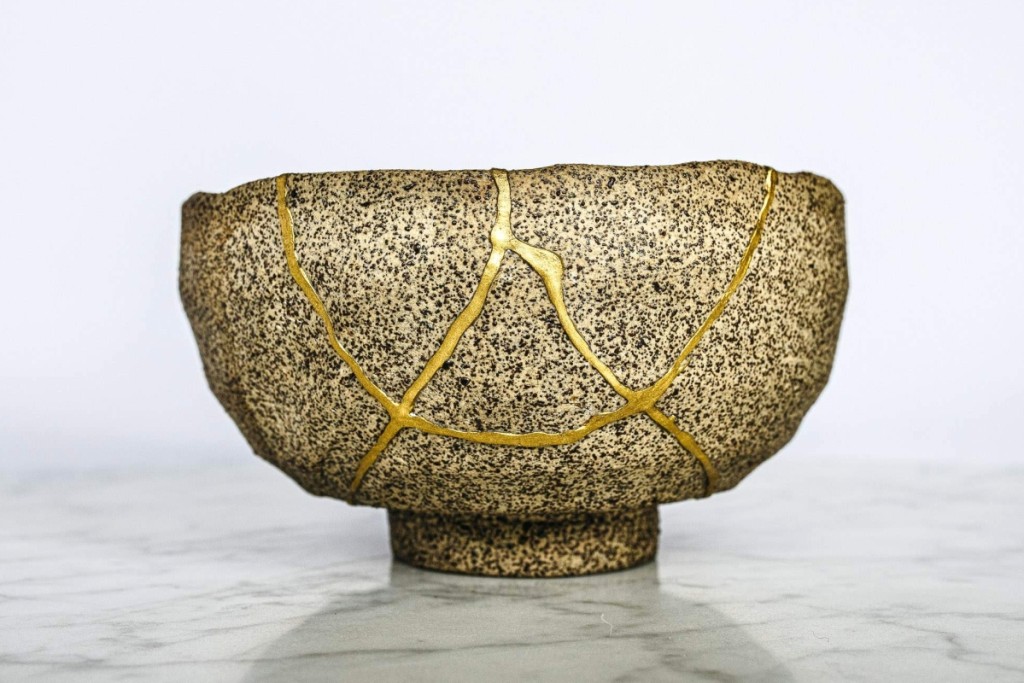
Hundreds of years ago, before adhesives were available in the Western world, broken ceramic vessels could be repaired with metal staples or rivets. Small holes would be drilled into the piece, staples inserted and then maybe some clay or paint would be applied to help conceal the repair.
Serviceable yes, but looking a bit like Dr Frankenstein’s monster. An ancient Japanese craft called kintsugi turns utility into art, however, and one of its modern day practitioners is Joseph Weaver, a self-taught artisan from San Francisco. We asked Weaver what drew him to this artful fix.
How did you come to learn this craft?
I started to learn about the art of kintsugi almost a decade ago. I was working as a Captain at Quince in San Francisco. Now it has three Michelin stars, at the time it had one. Chef Michael Tusk was running an incredibly tight restaurant, aiming to be one of the best in the city. He brought in beautiful ceramics for his dishes. As at all restaurants, breakage was a problem.
One day, the chef brought a bag of broken ceramics to a staff meeting and laid them out on a table. He has a background as a visual artist, so he suggested the only thing to do with these once-valuable objects was an art installation. I started imagining what could be done to resurrect these beautiful pieces with nowhere to go. I had seen pieces in museums as well as DIY attempts on social media. I decided to start working on it myself.
What is the literal translation of kintsugi, and how old is it?
The art form originated in the Fifteenth Century. Kintsugi means “to join with gold.” That’s what they started doing with broken pottery, often ceramics used in the tea ceremony. The method that they developed piggybacked off of Japan’s history for lacquerware, which involved using resin from the lacquer tree, toxicodendron ernicifluum. That resin, called urushi, acts as an incredibly strong binding agent if it is cured and oxidized correctly. When the urushi is dry, a layer of colorful powder, usually gold, is sprinkled on. This becomes the illumination of the fracture.
Are there any other Japanese concepts that this technique addresses?
In kintsugi, broken vessels not only return to a state of wholeness, but are also revered for their beautiful bond, honoring the Japanese concept of wabi-sabi. It’s a very complex idea, but part of wabi-sabi is about holding imperfection above perfection. Everyone can relate to flaws, which may be why people find this art form particularly compelling. They see themselves in the work.
What elements constitute the gold vein that runs through a repaired item?
The traditional method uses urushi to bond the sanded break. With this particular adhesive, the curing process could take weeks, months or even as much as a year, especially for plates (or vases, donabe pots, mugs, tagines, candleholders and platters) with more intricate puzzle pieces to reassemble. I am not bound to urushi, however; I also use other strong, food-safe polymers that dry in a matter of days. The final layer is always a finely ground gold or sometimes other metal.)
An example of a repair on an antique ceramic item?
Recently I repaired a chawan from the Sixteenth Century for a gentleman in Zurich. This is definitely the oldest piece I have worked on.
Ever purposefully broken a ceramic piece just to enhance it with a repair?
I have tried breaking pieces, but I am never able to replicate the elegance of a natural break.
You’re self-taught. How did you learn the secrets of kintsugi?
I thought about apprenticing with someone in Japan, which is the best way to deeply understand the traditional approach. But I also thought, maybe there’s a different way to do it – while still adhering to the traditional philosophy behind it. I knew the end result of what I wanted. I just needed to figure out how to get there. I took it on as a complete neophyte. For a long time, it was like feeling around in the dark. I tested out hundreds of different materials, adhesives, epoxies, colors, trying to replicate the style. I ended up creating a new formula and a new process for what I needed. Some of the main lacquers I use are actually custom made for me, it’s strong enough to go under a salamander, through a wash, be heated up to 650 degrees F. This is a new approach to an old art.
Are there other precious metals that work besides gold powder?
This really depends on the piece in question, but I often use bronze and platinum as well as gold. I have also used acrylic pigments for a more modern look.
Where can folks see examples of your work?
I am planning a show here in San Francisco for later this year, but in the meantime you can find information at my website – www.josephweaver.com – and instagram @josephcweaver.
-W.A. Demers





